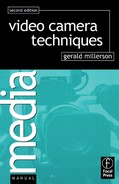Two important pieces of information are marked at the front of a zoom lens: its maximum and minimum focal lengths (in inches or millimeters), and its maximum aperture or f-stop.
If you change the lens’s focal length by altering the zoom lens setting, the subject will look correspondingly larger or smaller in the picture; and the impression of distance can alter. Double the focal length and your subject appears twice as large (apparently closer) – but only half the previous height and width of the scene is visible. At the same time, depth appears squashed.
If instead you halve the focal length, the subject is shown half the original size (apparently further away). The shot shows twice as much of the scene height and width than before. Depth appears exaggerated.
For convenience, people often refer to ‘using a two-inch lens’ for a scene. But you cannot accurately estimate a lens’s coverage, or the size and proportions that subjects will have from the focal length alone. For that, you need to know the lens angles. These you can work out from the focal length setting, and the size of the light sensor.
The camera lens show us a rectangular wedge of the scene in four by three proportions – i.e. an aspect ratio of 4:3 or 1.33:1. If it covers a horizontal angle of 40° for example (from left to right frame-edge), its vertical angle (from top to bottom frame) will be 30°.
The real advantage of thinking in terms of lens angles, rather than focal lengths, is that shot detail is completely predictable for any lens, with any size CCD or light sensor. If you draw the horizontal lens angle on a plan to any scale, it immediately reveals:
• The shots available from any camera position.
• The relative sizes of everything in the picture.
• Exactly what will appear in the shot, and what is lost outside the frame.
• The effect of changing the lens angle (i.e. zooming in or out).
As before, change the lens angle and the subject size will alter correspondingly.
Similarly, you can use the vertical lens angle (which is three-quarters of the horizontal angle) to check against scale elevations (side-views) of the scene, and see whether there is any danger of your shooting too high (overshooting).
Angle of view
The video camera’s lens sees in 4:3 proportions. So its vertical angle of view is three-quarters of its horizontal angle. The longer the focal length, the narrower the lens angle.
Camera formats compared
Image sensor size: 18mm (⅔in)
Image format: 8.8x6.6mm (0.35x0.26in)
‘Normal’ lens focal length about 11mm (0.4in)

Camera tube size: 25mm (1in)
Image format: 12.8x9.6mm (12.8x9.6in)
‘Normal’ lens focal length about 16-20mm (0.6-0.8in)


